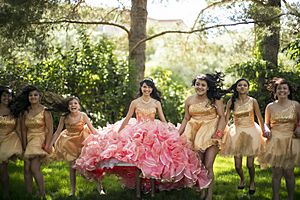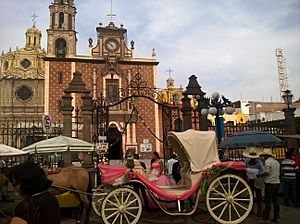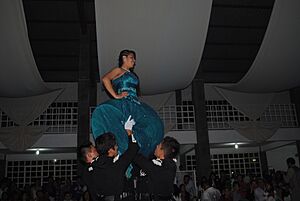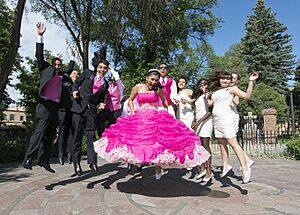Quinceañera facts for kids

A quinceañera is a special party that celebrates a girl's 15th birthday. It's very common in Mexico and other Latin American countries. The word quinceañera can mean both the celebration and the girl who is turning 15.
This birthday is different from others because it marks a big step. It shows a girl is moving from being a child to becoming a young woman. Long ago, girls learned important skills like cooking and weaving before they turned 15. This helped them get ready for their future lives.
The custom of the quinceañera is strongest in Mexico. It also happens in many other Spanish-speaking countries in the Americas. Some of these parties can be very grand, like big balls in Europe. Many Latino Americans in the United States also celebrate quinceañeras today.
In Brazil, which speaks Portuguese, a similar party is called festa de debutantes. In the French Caribbean and French Guiana, it's known as fête des quinze ans.
Contents
How the Quinceañera Started
The quinceañera celebration today mixes different traditions. It includes Catholic customs from old Spain and traditions from ancient Mexican cultures, like the Aztecs. There are also some modern ideas and European influences.
Long ago in Mexico, the Aztecs had ceremonies for different stages of life. The quinceañera marked a young woman's step into adulthood. She was presented to her community.
Some stories say the tradition also comes from European balls. For example, the Duchess of Alba in Spain held parties for young girls. Later, Empress Carlota of Mexico had similar events in Mexico City. These parties presented young women as ready for marriage. This is why quinceañeras often involve fancy ball gowns and ballroom dancing.
In a traditional Mexican quinceañera, the birthday girl has a court of honor. This includes formal damas (girls) and chambelanes (boys). They perform special dances. An "man of honor" also escorts the young woman.
How Quinceañeras Have Changed
Over time, the meaning of the quinceañera has changed. It has also been adapted by different Latino cultures.
In the past, girls in rural areas were seen as ready for marriage at 15. In the 1900s, turning 15 meant a girl could do more adult things. This included wearing makeup, jewelry, and high heels. At first, the quinceañera was a small party. Friends and family gathered so the girl could meet young men. Wealthy families had big parties with fancy dresses.
In the 1960s, many Latinos moved to the United States. They brought their traditions with them. Immigrants who found good jobs in the US could then afford big parties. These were like the ones they had in their home countries. Family and friends often help with the event, for example, by making food.
What started as a simple party with food and cake has become a huge event for some families. They might hire event planners. The celebration can have a theme, special entrances, and dances. Professional photoshoots and videos often capture the day. Modern quinceañera parties also include traditions from other cultures.
Quinceañera Traditions in Different Countries
Cuba
In Cuba, the party might include a special group dance. Fourteen couples waltz around the quinceañera. She dances with a boy she chooses. The dance often has four or six extra dancers called "experts." They help make the main couple stand out.
Fifteenth-birthday parties were very popular in Cuba until the late 1970s. This custom came partly from Spain, but mostly from France. Rich families would rent fancy rooms for their parties. These were the first quinces. Often, the parties took place at the girl's house or a relative's larger home.
Another Cuban tradition involves 14 girls and 14 boys as a court. The boys hold flowers, and the girls carry candles. As the quinceañera dances with her father, she blows out one candle and picks up one rose. She does this 14 times. Each candle blown out stands for one of her past 14 years. She makes a wish with each one. When she cuts the cake, she blows out her last candle, completing her 15 wishes. The flowers are given to her mother.
Colombia
In Colombia, the quince party starts when the birthday girl arrives with her father. Her mother and other family and friends greet her. The father and daughter dance a waltz. Then, the quinceañera dances with her brothers, uncles, and godparents. She also dances a pasodoble and waltz with everyone in her court. Other music like merengue or pop might also be played.
For this day, the girl wears a light-colored evening dress. She has light makeup and often a tiara in her hair. She also wears jewelry. All the guests dress formally.
After the first dance, the girl and her friends have a dance. Then the party really begins with live bands, DJs, food, and drinks. Later in the night, there is a la hora loca (the crazy hour). During this time, guests wear masks or funny wigs. They make noise with whistles and rattles while fast music plays. The quinceañera might also do a surprise dance.
This custom is so important that even families with less money try to spend a lot on a daughter's quinceañera. The party can cost as much as a year's pay. Many families go into debt to pay for it.
Mexico
In Mexico, the quinceañera wears elegant jewelry and makeup. Traditionally, this was her first time wearing makeup in public. But today, girls often start using makeup earlier. The quinceañera also wears a formal evening dress. This is usually a long, fancy ball gown chosen by the girl and her mother.
In the Mexican Catholic tradition, the celebration starts with a special church service called a thanksgiving Mass. The girl goes to church with her parents, godparents, and court of honor. The court is a group of her chosen friends, both girls (damas) and boys (chambelanes). There are usually 7 to 15 pairs. During the Mass, her godparents give her a Rosary or a necklace. It might have a locket with the Virgin of Guadalupe, Mexico's patron saint. The priest blesses this gift. She also gets a tiara. This reminds her that she is always a "princess" to her family and before God. After this, the girl might leave her flower bouquet on the altar for the Virgin Mary.
After the Mass, guests go to a party to celebrate the quinceañera. This party can be at her home, a special event hall, or even a public place. At the party, the birthday girl usually dances a traditional waltz with her father. They choose a song that means something to them. Then her father passes her to her chosen escort, the chambelán de honor. After that, she dances with the rest of her court. This dance is often practiced and choreographed for weeks or even months.
A basic Mexican quinceañera party has six main parts with dances:
- The formal entry (La Entrada) – The quinceañera makes a grand entrance after guests are seated.
- The formal toast (El Brindis) – Parents or godparents usually give a toast to the birthday girl.
- The first dance – The girl dances a waltz, starting with her father.
- The family dance – A waltz danced only by close relatives, the chambelanes, godparents, and close friends.
- The preferred song (Baile Sorpresa) – A modern song the quinceañera loves is played and danced to.
- The general dance – Another traditional waltz.
Traditionally, Mexican girls could not dance in public until they turned 15. So, the waltz with her chambelanes is a big deal. It celebrates her first public dance.
Some families add special ceremonies. One is the Change of Shoes. A family member gives the quinceañera her first pair of high heel shoes. Another is the Crowning ceremony, where a relative places a crown on her head. The ceremonia de la ultima muñeca (ceremony of the last doll) is also common. Her father gives her a doll, often dressed like her. This ceremony is based on a Maya tradition. It means the girl is growing up and leaving childhood toys behind.
After all the special moments, dinner is served. Live music groups play, and guests eat, chat, and dance. The next morning, family and close friends might have a special breakfast. Sometimes, leftover food from the party is warmed up for a brunch.
The quinceañera party is a very strong tradition for most Mexican people.
United States
In most of the United States, a sweet sixteen is a common birthday celebration. However, the quinceañera is popular among the large Mexican American population. This includes areas from California to Florida. It's also celebrated by other Hispanic communities across the country and in Puerto Rico.
Quinceañeras were celebrated in the US in the mid-1970s and early 1980s. Many working-class families could afford them because `padrinos` (godparents) and `padrones` (sponsors) helped with the costs. In recent years, quinceañeras have become even more popular in the United States. Books and other materials about quinceañeras are now often available in English. This shows how Hispanic and Latino culture is growing in American culture. More businesses are now focusing on products and services for young Hispanic or Latina women celebrating their quinceañera.
New Quinceañera Traditions
In the 21st century, many girls are creating their own unique quinceañera celebrations. Traditional dresses used to be only white and very formal. Now, dresses come in many colors and styles. Also, instead of having the traditional seven damas and seven chambelanes, a girl might choose all damas or all chambelanes.
In the past, girls were not allowed to dance in public until they turned 15. But this rule is not as strict anymore. The ceremony of the Change of Shoes has also changed. Instead of wearing slippers and then changing into high heels, a girl might just wear shoes that match her dress.
Adult Quinceañeras
Since 2018, a new trend has appeared. Some Latin American adults are celebrating the quinceañera they never had when they were 15. As times have changed, quinceañeras have become more personal. They can include professional dancers or pop culture themes, like a Harry Potter party. Many Latina women are now having their dream celebrations as adults. This is often because they couldn't have one before due to money problems, family issues, or pressure from parents.
See also
 In Spanish: Fiesta de quince años para niños
In Spanish: Fiesta de quince años para niños




